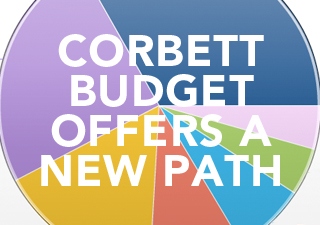Commentary

Corbett Budget Offers a New Path
This Commentary first appeared in the Allentown Morning Call.
Albert Einstein defined insanity as “doing the same thing over and over again and expecting different results.” For too long Pennsylvania state government has been spending beyond its means and the result is clear—high taxes, massive debt and stagnant economic growth. Gov. Corbett’s budget represents an important step along a different path that puts taxpayers first.
The state operating budget increased from $4 billion in 1970 to more than $65 billion today. Adjusting for inflation and population growth, this represents an increase of $3,229 for every man, woman, and child in Pennsylvania. As a result, the Keystone State has the 10th highest state and local tax burden in the nation, and residents must work 103 days—nearly one-third of the year—to earn enough money just to pay their federal, state, and local tax bills.
While the state constitution requires a balanced budget, the state borrows money each year as part of the capital budget, and independent state agencies like the Turnpike Commission issue additional debt. Over the last eight years, total Pennsylvania state debt increased 82 percent, from $23.65 billion to over $42.94 billion.
Unfunded pension liabilities further burden state taxpayers. Act 120 of 2010 delayed paying off this debt, as lawmakers decided it was unaffordable. But this further underfunds the plans, and fails to offer a strategy for reducing taxpayers’ growing liabilities. Combined, Pennsylvanians now owe more than $62,000 per family of four in state and local government debt and long-term obligations.
All this spending and borrowing has failed to stimulate Pennsylvania’s economy. From 1970 to 2010, Pennsylvania ranked a dismal 47th in job growth, 46th in personal income growth and 47th in population growth.
Facing this fiscal crisis and economic stagnation, Gov. Corbett and lawmakers need to adopt a different approach to spending. Elected officials should answer these four questions before beginning the budget process:
- What are the core functions of state government?
- How much money does the state have available to spend?
- What is the most efficient and effective way to deliver essential services within available funds?
- How will state government measure its progress and success?
Examining spending through the lenses of the core functions of government, efficiency in delivering service and getting results from the use of taxpayer dollars lends itself to the following recommendations.
- End discretionary economic development subsidies. Grants, loans and tax breaks for the politically connected—while imposing higher taxes on everyone else—undermines economic growth. Programs like the film tax credit, corporate welfare and other economic development programs only shift resources, they do not create jobs.
- End RACP borrowing. Given Pennsylvania’s debt burden, ceasing to borrow money for private developments—like funding sports stadiums, aiding TastyKake and other corporations or building the Arlen Specter Library—should be a no-brainer.
- Improve the efficiency and quality of Medicaid. Pennsylvania’s Medical Assistance program consumes an ever-increasing share of state spending and delivers low-quality care. Reforming Medicaid by helping individuals buy private coverage, addressing rampant fraud and limiting long-term care funds to the truly needy would improve efficiency and quality.
- Privatize state liquor stores. Government should never have gotten into the business of selling alcohol, and now is the time to let private sector do this—like 48 states do.
- Reform education with school choice and mandate relief. Allowing funding to follow children to their school of choice would improve the quality of education at a fraction of the cost of the $13,000 per pupil school districts spend. Freeing school districts from costly mandates that do nothing to improve learning is also critical to government efficiency.
- Enact reasonable limits on the growth of state spending. Once state government has been restored to its core functions, spending growth should be limited to the costs of providing these functions. If General Fund spending had been limited to inflation plus population growth over the last eight years, Pennsylvania would be enjoying a surplus this year.
Building a reality-based budget requires legislators to first understand the causes of Pennsylvania’s fiscal challenges—years of overspending. Gov. Corbett’s budget proposal recognizes the commonwealth’s spending problem, makes many of the reforms needed and begins addressing state spending from the perspective of the taxpayer. While much work remains, Corbett’s first budget charts a new course towards a budget based in reality.
# # #
Nathan A. Benefield is Director of Policy Research with the Commonwealth Foundation (www.CommonwealthFoundation.org), an independent, nonprofit public policy research and educational institute based in Harrisburg.